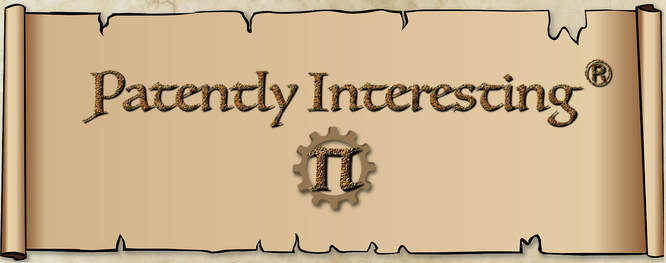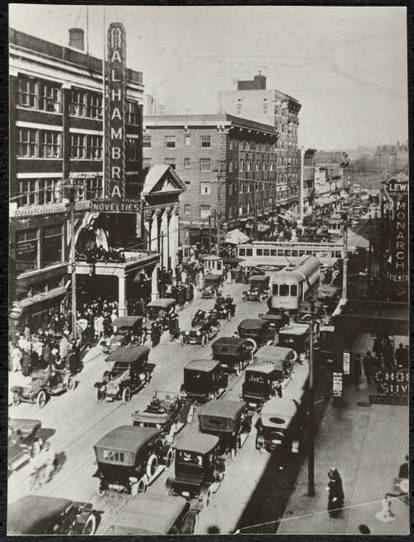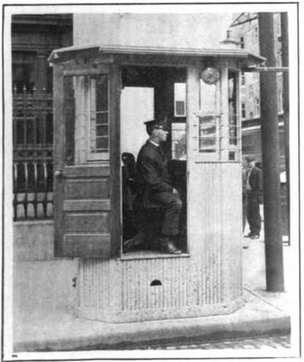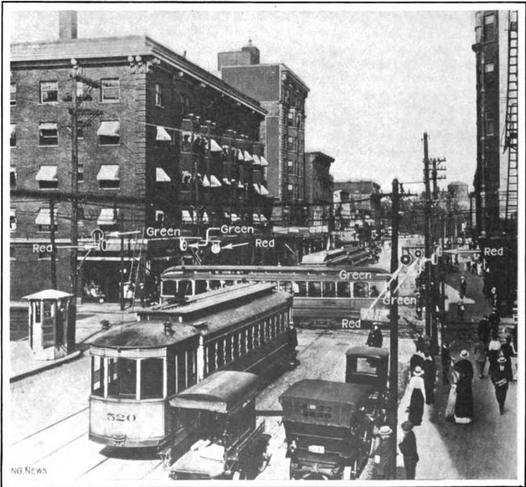 Intersection of Euclid Avenue & E. 105th Street, circa 1915
Intersection of Euclid Avenue & E. 105th Street, circa 1915
On August 5 of the year 1914, at 5:00 PM, the first electric traffic lights in the U.S. went into operation in Cleveland, Ohio. The traffic lights were part of a system that had been designed and installed by the American Traffic Signal Company of Cleveland at the corner of Euclid Avenue and E. 105th street. The installed system was generally based on a system that had been patented by James B. Hoge of the American Traffic Signal Company (U.S. Patent No.: 1,251,666).
The installed system included four poles mounted at the four corners of the intersection, respectively. Fifteen feet above the ground, a pair of cantilevered bars extended from each of the poles, with the bars in each pair being arranged at right angles to each other. A round signal light hung from each bar in the pair. One signal light was red and one signal light was green. The lights were arranged such that each approach to the intersection was provided with two lights: one red light located on the near side, indicating "Stop", and one green light located beyond the street intersection, indicating "Start". Thus, the lights of one pole were applicable to two different streams of traffic traveling on the two different roads. The photograph to the left shows this arrangement. \
In addition to the signal lights, bells were also mounted to the poles, respectively. The bells would be rung to indicate which flow of traffic was to proceed. Two long rings would signal that traffic on Euclid Avenue should proceed and one long ring would signal that traffic on E. 105th street should proceed.
The signal lights and the bells were controlled by a traffic officer located in a traffic booth at one of the corners. More specifically, the signal lights and the bells were controlled by a single switch. When the stop signal lights and the bells stopped traffic on one road, the start signal lights and the bells allowed traffic to flow on the other road.
The installed system included four poles mounted at the four corners of the intersection, respectively. Fifteen feet above the ground, a pair of cantilevered bars extended from each of the poles, with the bars in each pair being arranged at right angles to each other. A round signal light hung from each bar in the pair. One signal light was red and one signal light was green. The lights were arranged such that each approach to the intersection was provided with two lights: one red light located on the near side, indicating "Stop", and one green light located beyond the street intersection, indicating "Start". Thus, the lights of one pole were applicable to two different streams of traffic traveling on the two different roads. The photograph to the left shows this arrangement. \
In addition to the signal lights, bells were also mounted to the poles, respectively. The bells would be rung to indicate which flow of traffic was to proceed. Two long rings would signal that traffic on Euclid Avenue should proceed and one long ring would signal that traffic on E. 105th street should proceed.
The signal lights and the bells were controlled by a traffic officer located in a traffic booth at one of the corners. More specifically, the signal lights and the bells were controlled by a single switch. When the stop signal lights and the bells stopped traffic on one road, the start signal lights and the bells allowed traffic to flow on the other road.
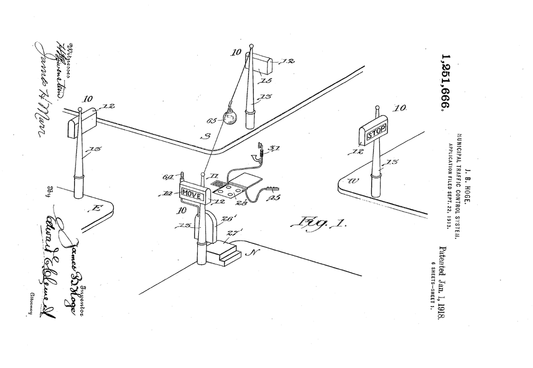 U.S. Patent No.: 1,251,666
U.S. Patent No.: 1,251,666
The traffic booth was also electrically connected to the headquarters of the Cleveland Fire Department so as to receive advance notice when a fire truck would pass through the intersection en route to a fire. Upon receiving such a notice, the traffic officer would activate a master emergency switch, which would automatically shut off all the green signal lights and cause the red signal lights to flash and the bells to continuously clang. After activating the master emergency switch, the traffic officer would leave the booth and enter the intersection to clear any stopped traffic.
The installed system differed from the system of the '666 patent in a number of ways. Most significantly, the system of the '666 patent had only one signal box mounted to each pole, instead of the two signal lights of the installed system. The signal box could alternately display the lighted words "STOP" or "MOVE", but contemplated alternately displaying different colors, instead of different wording, with a red light indicating "stop" and a white light indicating "move".
The system of the '666 also disclosed having a traffic station in the center of an intersection in addition to or in lieu of the traffic booth located on one of the corners. The traffic station in the center of the intersection had foot pedals mounted flush with the pavement that could be activated by the foot of a traffic officer located in the center of the intersection. Activation of the foot pedals controlled the signal boxes.
On August 5, 1914, the traffic signal system at the corner of Euclid Avenue and E. 105th street worked as designed. However, to ensure that motorists followed the system, a traffic officer was stationed in the center of the intersection to direct traffic. While the presence of a traffic officer in the intersection was only meant to be temporary, it most likely lasted for a much longer period of time. Based on writings from the time, it appears that motorists had great difficulty adjusting to automated traffic signal systems. In a 1916 letter from the Cleveland Automobile Club, the writer stated: "We believe Cleveland was the first city in the country to try out semaphore or automatic signals suspended above the street, inasmuch as the devices were invented here. I have come to the conclusion, however, that nothing can take the place of the human officer in the middle of the street.
The installed system differed from the system of the '666 patent in a number of ways. Most significantly, the system of the '666 patent had only one signal box mounted to each pole, instead of the two signal lights of the installed system. The signal box could alternately display the lighted words "STOP" or "MOVE", but contemplated alternately displaying different colors, instead of different wording, with a red light indicating "stop" and a white light indicating "move".
The system of the '666 also disclosed having a traffic station in the center of an intersection in addition to or in lieu of the traffic booth located on one of the corners. The traffic station in the center of the intersection had foot pedals mounted flush with the pavement that could be activated by the foot of a traffic officer located in the center of the intersection. Activation of the foot pedals controlled the signal boxes.
On August 5, 1914, the traffic signal system at the corner of Euclid Avenue and E. 105th street worked as designed. However, to ensure that motorists followed the system, a traffic officer was stationed in the center of the intersection to direct traffic. While the presence of a traffic officer in the intersection was only meant to be temporary, it most likely lasted for a much longer period of time. Based on writings from the time, it appears that motorists had great difficulty adjusting to automated traffic signal systems. In a 1916 letter from the Cleveland Automobile Club, the writer stated: "We believe Cleveland was the first city in the country to try out semaphore or automatic signals suspended above the street, inasmuch as the devices were invented here. I have come to the conclusion, however, that nothing can take the place of the human officer in the middle of the street.

